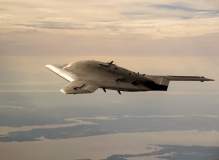
After carrying out a number of shore-based trials, X-47B began ship-based demonstrations, starting with flight-deck taxiing in December 2012 on another Nimitz-Class nuclear powered aircraft carrier, the USS Harry S Truman.
Conducted by sailors aboard the aircraft carrier and personnel from the navy’s unmanned combat air system programme office (PMA-268) integrated test team, the UCAS demonstrator performed successful integration with the Truman’s flight deck during the trials.
X-47B starts at-sea trials
Later that month, the programme moved on to at-sea trials. Conducted at Naval Station Norfolk and off the coast of Virginia, the trials involved successful integration of the UCAS demonstrator with Truman’s flight deck using an arm-mounted control display unit (CDU), remotely-controlling and moving over the arresting wire, to and from the catapults and to various spotting positions.
The strike-fighter-sized aircraft also conducted fuelling operations and had its digital engine controls tested within an electromagnetic field-surrounded environment.
The programme had a bit of a hiatus through early spring, before moving on to launch and landing demonstrations in early May. Initial trials took place on dry land, with the X-47B completing fly-in arrested landing trials at the US Navy’s shore-based catapult and arresting gear complex at Naval Air Station Patuxent River, Maryland, US.
During testing, the demonstrator was steered remotely into land and brought to a stop by catching a carrier-representative MK-7 arresting gear, extended across the aircraft landing area, using its landing tailhook, as can be seen on the first video.
By the middle of the month, the X-47B successfully completed its first carrier-based catapult launch from the USS George H W Bush (CVN 77) off the coast of Virginia, US, flying autonomously for 65 minutes before landing safely at Naval Air Station (NAS) Patuxent River.
Touch-and-go triumph for the UCA aircraft
The launch proved the team’s ability to navigate the X-47B precisely within the controlled airspace aboard the aircraft carrier, and seamlessly pass control from a ‘mission operator’ aboard the ship to the Mission Test Control Centre at Patuxent River.
Towards the end of May, the X-47B undertook near-operational style flights from the aircraft carrier, carrying out touch-and-go landings; a significant milestone in the journey towards bringing unmanned carrier aviation (UCA) aircraft into service.
Also known as "circuits and bumps", a touch-and-go sees the aircraft touch its wheels to the flight deck, speed up, then take off again, without coming to a halt.
Don Blottenberger, the navy’s UCAS-D deputy programme manager, said: "This landing, rubber hitting deck, is extremely fulfilling for the team and is the culmination of years of relative navigation development. Now, we are set to demonstrate the final pieces of the demonstration."
The next stage for the UCAS-D programme will see the X-47B carrying out more shore-based arrested landings at Patuxent River, before final carrier-based arrestments later in 2013.
Related content
Video feature: Showboat – DCNS showcases FREMM frigate to Canada
French shipbuilder DCNS has released footage of its first FREMM frigate Aquitaine arriving in New York ahead of a visit to Canada, with the aim of turning a few armed forces heads.
Radar in 2013 – a technology that just keeps on detecting
Despite the general downturn in defence budgets, radar development and procurement has remained relatively strong, bucking the wider trend of reduced spending.
Follow Berenice Baker on Google+


.gif)

